
Table of contents:
- Author Bailey Albertson [email protected].
- Public 2023-12-17 12:53.
- Last modified 2025-06-01 07:32.
Cat litter box: everything an owner needs to know
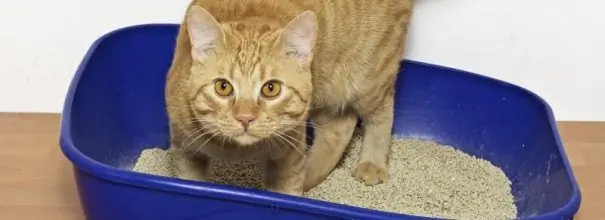
The litter box is one of the essentials for a domestic cat. This is his latrine, so choosing the right type of toilet is a top priority if you want your pet to feel comfortable and not “do his business” in the wrong place.
Content
- 1 What is a cat litter box and why is it needed
-
2 Varieties of cat litter
-
2.1 Tray
- 2.1.1 Classic
- 2.1.2 With mesh
- 2.2 House
- 2.3 Corner toilet
- 2.4 Dry closet
- 2.5 Automatic toilet
-
2.6 Toilet Training Tray
2.6.1 Video: Toilet Training for a Cat Using the Trainer Tray
-
-
3 How to choose a cat litter box
3.1 How to determine the type and size
- 4 Where to install the tray
-
5 How to train a cat to toilet
5.1 Video: veterinarian advice on litter training
What is a cat litter box and why is it needed
A cat litter box is a relatively small container with special litter designed as a litter box for pets. Many people do not know that the "cat" tray is often used as a toilet for indoor decorative dogs, rabbits, ferrets and other similar animals. But the most common use of this kind of toilets is for cats.
Also, cats have a habit of going to the toilet in the same place. What caused this behavior and how exactly the cat chooses a suitable place - there are no unequivocal opinions on this. But the cat litter is able to satisfy all the needs of the animal in this matter.
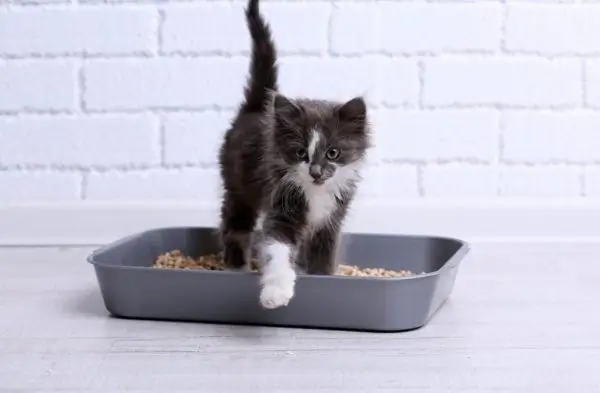
For a domestic cat and its owner, a litter box is a necessary hygiene item.
Varieties of cat litter
The behavior of your furry pet largely depends on the correct choice of cat litter - whether it will regularly "walk" where it should. Otherwise, you can find a "puddle" or "heap" anywhere in your house, even on your bed.
Contrary to popular belief, cat litter today is produced in a wide variety of types, up to high-tech automated autonomous devices, not all of which would be correctly called a litter box.
Tray
Open boxes for cat needs have been used since the 17th century. They had low sides and were filled mainly with sand. The modern type of cat litter box comes from the inventor Edward Lowe, who created this product in 1947.
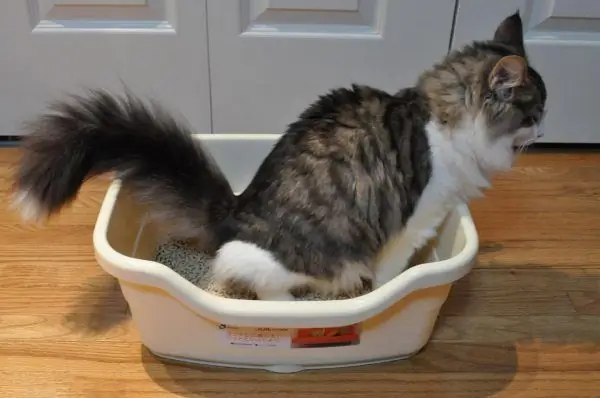
The classic litter box is a simple product that meets the basic requirements of a cat and its owner
Classical
The classic cat tray is an open rectangular container with dimensions of about 30x60 cm and a side height of 10-20 cm. Such products are made of plastic. Various models have design features, for example, many have an additional plastic visor that is attached around the perimeter of the main rim to prevent the cat from scattering the litter during instillation. Also, an additional side allows you to fix the oilcloth at the bottom of the tray, which simplifies the process of cleaning it.
Classic trays can be roughly divided into two types - with a high and a low side. The low-sided litter box is an option for very young kittens. It is suitable for training an animal to the toilet, but already at the age of three months you can safely change it to a regular one, with high sides that minimize the amount of filler scattered during burial.
The author of this article has a wonderful red-haired cat of the European ordinary breed. She came to my house at the age of three months. As a toilet for her, an ordinary plastic tray with high sides and an additional visor was immediately chosen. No problems in use have arisen either in feline childhood or today. The animal is already 5 years old, and the tray still serves well. Any filler can be used in it. I don’t use any kind of tape because I don’t find it convenient. One "but" - from the acid contained in cat urine, a kind of plaque appeared at the bottom of the tray, which, however, does not have a smell and does not in any way interfere with the animal itself. So I can safely recommend a similar type - such trays are practical, durable and cheap. The price of such a product today hovers around $ 4-6. You can find more expensivebut it makes no sense.
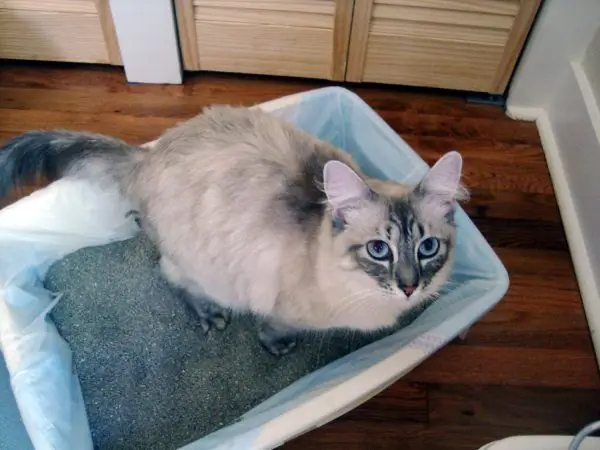
A special plastic bag fixed to the sides makes cleaning the tray easier
With mesh
The mesh tray differs from the classic one with a plastic grate installed on its bottom. This type of toilet is convenient because it can be used without any filler - the animal “walks” directly on this net. In this case, the tray will have to be washed after each visit with the cat, otherwise the characteristic smell will spread throughout the apartment.
Often, trays with a net are chosen for long-haired cats, which, when going to the toilet with filler, carry out its particles on their fur - on the legs, tail and "panties". But not all cats accept this type of product; for some, the burying process is extremely important.
From the personal experience of the author of the article. Friends have a wonderful cat Misha. He came to them as a small kitten, but as a result he grew into a huge animal with very long thick hair. After going to the toilet, he distributed the filler throughout the apartment, regardless of its type and size of the granules. Everything stuck to his fur. As a result, the strategic decision was made to switch from a regular litter box to a toilet with a mesh. Misha refused to "walk" on him at all. No threats, no persuasion, no encouragement - nothing helped. We came to a consensus - being a smart cat, Misha went to the bathroom on the tiles in the same place, so after each of his such episodes someone has to go and clean up the excrement, because it's easier than cleaning the whole apartment every time. So if you are a lucky owner of a long haired cat,it is better to accustom him to a certain type of tray from childhood, because then the animal may refuse to change its habits.
The cost of trays with mesh should not exceed $ 6-7.
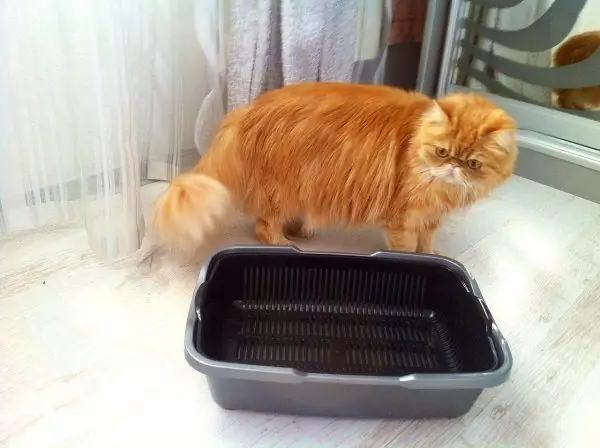
For long-haired cats, mesh trays are best.
House
The house tray, or closed tray, differs from the usual clip-on or monolithic upper part, which forms a kind of house, similar to a doghouse. Such a toilet looks more aesthetically pleasing, completely prevents the scattering of the filler during instillation. The animal feels comfortable and protected in it.
Some types of closed toilets offer the possibility of mechanical sifting of crumpled elements and excrement, which, when the tray is turned over, is separated into a separate slot, which is then simply shaken out into the trash can.
Also, the house tray can be a kind of dry closet, but this is a different type of toilet, which we will discuss below. Depending on the manufacturer and functionality, a closed tray can cost anywhere from $ 20 to $ 100.
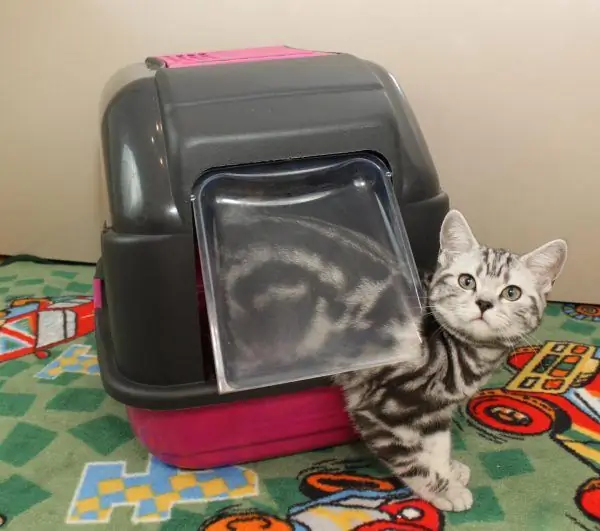
In the house tray, the animal feels protected, moreover, this design looks more aesthetically pleasing
Corner toilet
A corner toilet is defined as a regular or closed tray, suitable for placement in the corner of a room. The corner toilet does not imply functional differences.
The open version of the corner tray costs 10-12 dollars, the closed one will cost you 20-30 dollars.
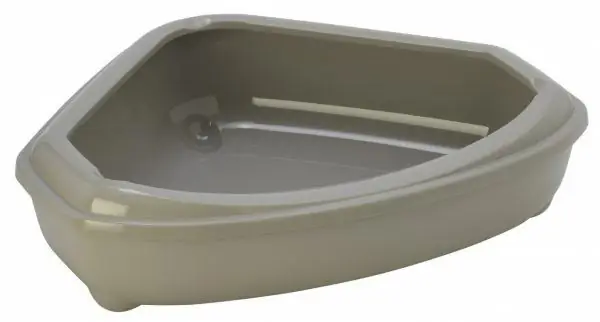
Corner tray differs from the classic only in shape
Dry closet
The dry closet for cats is a closed model of a tray with a charcoal filter installed in it. The charcoal filters are located on the lid and prevent unpleasant odors. Otherwise, this is a normal closed-type tray.
The main disadvantage of this kind of toilets is that replaceable filters are not sold everywhere, most likely you will have to order them via the Internet. The filter will have to be changed every 2-3 months and costs $ 8-10 for 3 pieces. The tray itself will cost you $ 20-30.
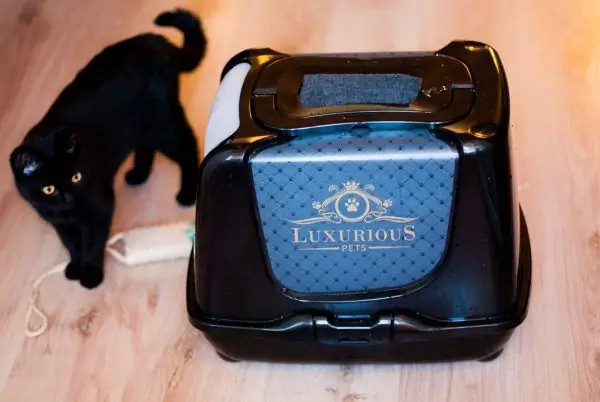
In the model shown, the charcoal filter is located on the top cover and covered with a piece of felt cloth
Automatic toilet
Modern automatic trays are automated complexes that require a minimum of human participation in their maintenance. So, the excrement in them is automatically disposed of in a special container. Such models require connection to the mains, and some - to the sewerage and water supply (they use a filler of constant use, suitable for washing and drying, and excrement is immediately washed off into the sewer).
Self-cleaning processes in such trays are activated by pressure sensors or infrared sensors some time after the animal leaves the tray. Cats do not have any difficulty in using automatic toilets, as well as humans in servicing this technique. This is a great option for those who are often away or simply do not have the desire to constantly clean up after the animals.
The main disadvantage of such trays is their price. A regular self-cleaning tray starts at $ 250, and models that also connect to sewers and plumbing have a price tag of at least $ 700.
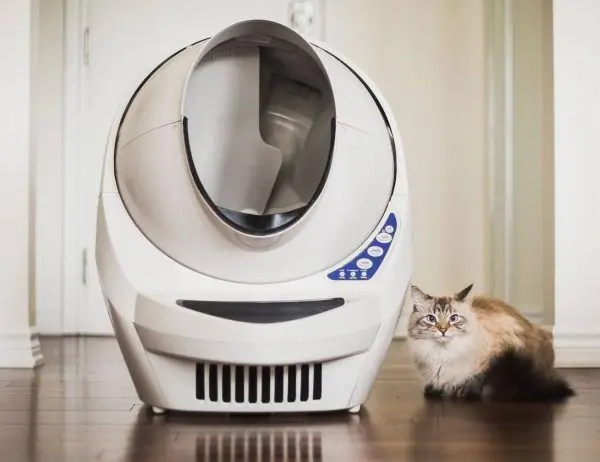
Japanese self-cleaning toilet Litter Robot does not require human intervention
Toilet Trainer Tray
In recent years, it has become common practice to train cats to go to the toilet directly into the toilet. For this, universal training trays are used. This method is available for cats over three months old who are litter-trained. The toilet training process will take 3 to 6 months.
The tray itself is made of PVC or plastic and fits under the toilet seat. Initially, it completely closes the hole, a small layer of filler is poured over it, which can be flushed down the drain. In order to attract the animal to the toilet, you can initially put the tray that is familiar to him there, and after several visits, remove it. Then it is necessary to make a small hole in the training tray in the very center and increase it from time to time. In factory trays, these contours are pre-defined. Thus, after 3-6 months, the animal will get used to doing its thing in the toilet, becoming its paws on its seat.
The disadvantage of this method is hygiene - after all, the cat jumps on the toilet seat, where you will then have to sit. Also, all sorts of incidents are not uncommon, for example, a cat misses the toilet or an animal slips inward. However, some cats even learn to flush after themselves, so this type of cat litter organization also takes place.
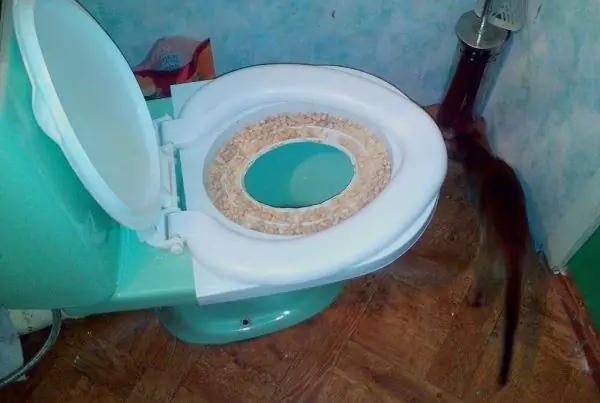
Using the training tray, you can train your pet to go to the toilet directly on the toilet
Video: training a cat to the toilet using a training tray
youtube.com/watch?v=ipBczRLCmxI
How to choose a cat litter box
The main criteria for choosing a cat litter are:
- design;
- the size;
- cost;
- convenience for the owner of the animal.
Choosing a toilet is best before you have a pet.
How to determine the type and size
It is best to choose the type of tray and its dimensions based on your knowledge of what breed of cat will live with you, what is your own rhythm of life.
The toilet must be chosen, focusing on the estimated or actual dimensions of an adult cat - she should be comfortable in the tray, she should be able to fit entirely and unfold in it.
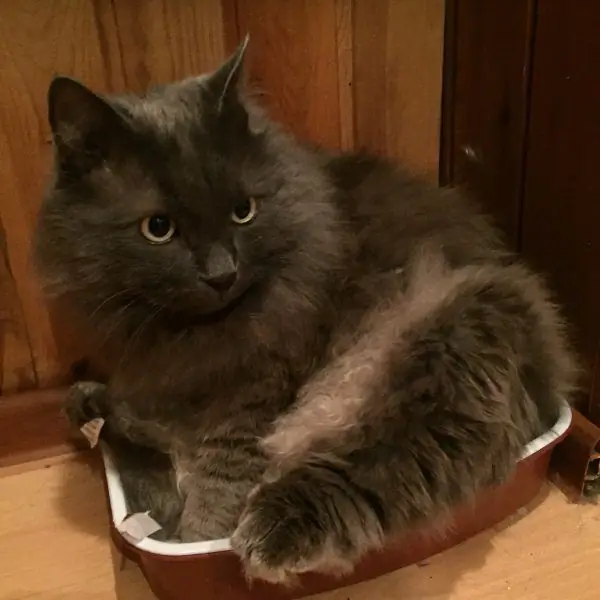
An adult cat will feel uncomfortable in a small tray, so you should promptly replace the product with a more suitable size
The size of the litter box must be appropriate for the size of the cat. For kittens 1-2 months old, small trays with low edges are often bought. For kittens over three months old, you can use ordinary trays - the animals are already mobile enough to get into the toilet with very high sides without any problems.
The type of tray is solely the choice of the owners. Do what is more comfortable for you and your pet. And don't forget about the cost of the litter box - fully automated systems are probably the best choice, but are you willing to spend more than 35,000 rubles on a litter box? On the other hand, if you have to travel often on business trips, have increased disgust, or are lucky enough to have an animal that needs cleaning after each trip to the toilet, this price may be adequate to resolve these issues once and for all.
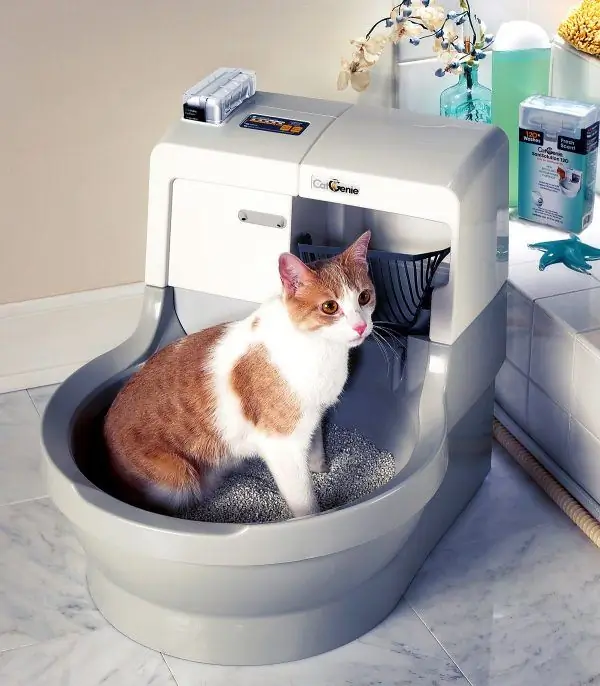
The automatic cat litter box requires only periodically adding new litter and shaking out the waste container
Where is the best place to install the tray
The two most common places for a cat litter box are the bathroom and the hallway. Some owners install a tray on the loggia. Basic requirements for the location of the cat litter box:
- constant availability for the animal;
- seclusion, so that the animal does not interfere with doing its affairs;
- convenience for the owners, so that the tray does not interfere with them.
The author of this article has a cat tray in the bathroom, which is combined with a toilet. It is located on the side of the toilet. There are no problems. Despite the high sides, a little sand is still scattered when burying, but it does not spread throughout the apartment. It is also not difficult to sweep it when cleaning the tray itself.
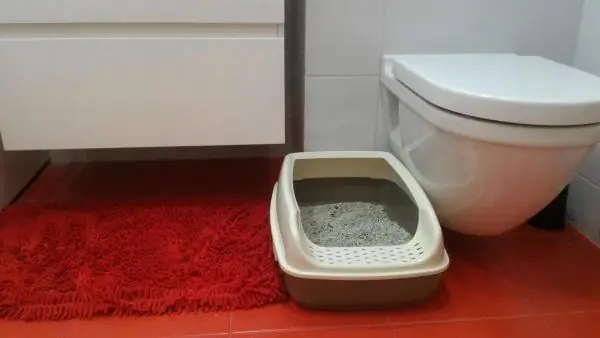
The location of the litter box next to the toilet, if the room has free space for this, is the most rational solution.
How to toilet train your cat
Cats instinctively seek a burrowing surface to meet their natural needs. If you are training a kitten to the litter box, you just need to put it in the litter box several times, take its foot and help it to make digging movements. If the animal went in the wrong place, it cannot be scolded. It is better to take a small piece of cloth or newspaper, soak it in the pet's urine and carry it to the tray, and then take the animal itself there. Such a hint often works, and the necessary instincts are activated.
The author of this article was faced with the problem of training a three-month-old kitten to the litter box. The kitten was outside and went to bed on the very first night. As a result, the cat's "cases" were removed, and the tray was put in the same place. The second time the cat went into it. The third time too. But this arrangement of the tray did not suit me, and for the fourth time I put the tray in front of the bed. The cat went into it again. As a result, step by step, the tray was in the right place for me, and there were no more problems with its use.
Tray training an adult outdoor animal can be a little more difficult. If the methods described above do not help, you need to monitor the pet and as soon as he begins to prepare to go to the toilet, carefully transfer him to the tray. This procedure should be repeated regularly, and the animal should be encouraged after it has gone to the toilet in the right place.
If no tricks work and the animal continues to go to the toilet in different places, there is a possibility that he is incontinent and it is better to sign him up for a checkup with a veterinarian.
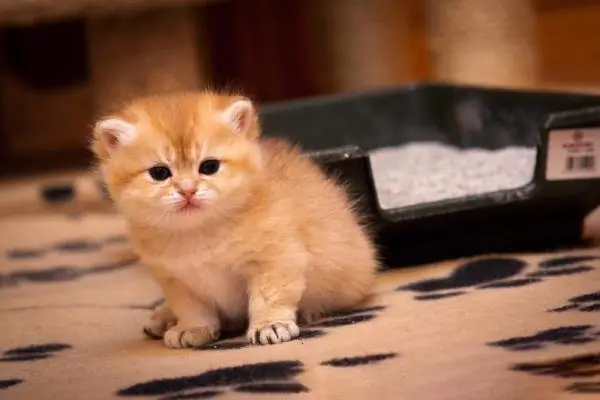
It is necessary to train the cat to the litter box from a very early age, when stable behavioral reactions are formed.
Video: veterinarian advice on litter training
To equip your cat's life with maximum comfort for him, you need to follow his habits and preferences, not be afraid to experiment and do not forget about your own convenience. In this case, the choice of a suitable tray and filler for it, as well as accustoming the animal to it, will not be difficult.
Recommended:
What Litter For Cat Litter Are And How To Choose The Best One + Reviews And Videos
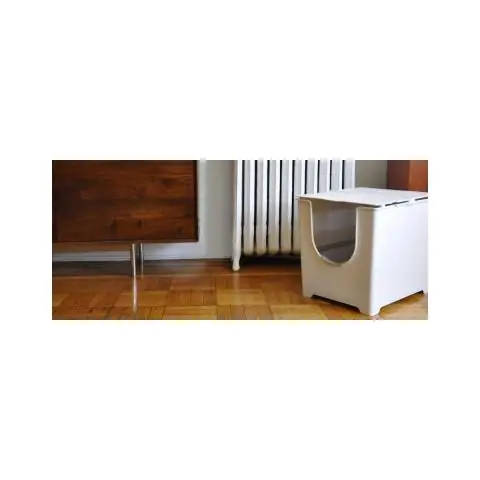
How to choose the perfect kitty litter. Criterias of choice. Customer reviews. Rating of the best manufacturers. Video
How To Wash Sneakers In A Washing Machine (including An Automatic Machine) Correctly, And Then Dry Your Shoes
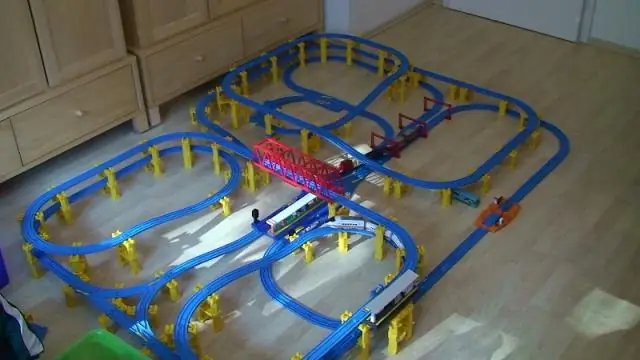
Tips for washing sneakers in a washing machine step by step. Nuances, features, use of special products, drying rules
How To Train A Cat Or Cat To A Scratching Post, Including In The Form Of A House: Features Of Training Kittens And Adult Animals, Recommendations And Reviews
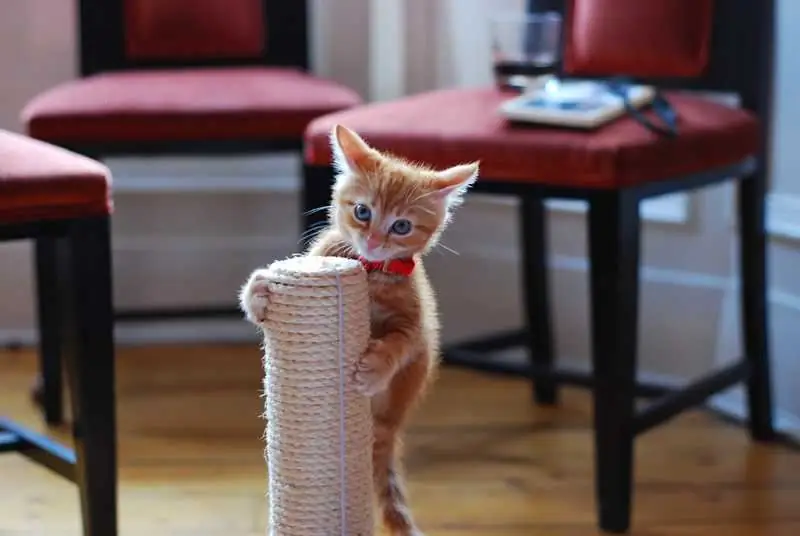
Why cats need to sharpen their claws. How to draw your pet's attention to a device. What to do if your cat doesn't want to use the scratching post
Cat Litter: How To Choose The Best, Types (clumping, Absorbent), Ever Clean, "Golden Cat", "Barsik" And Others, Reviews
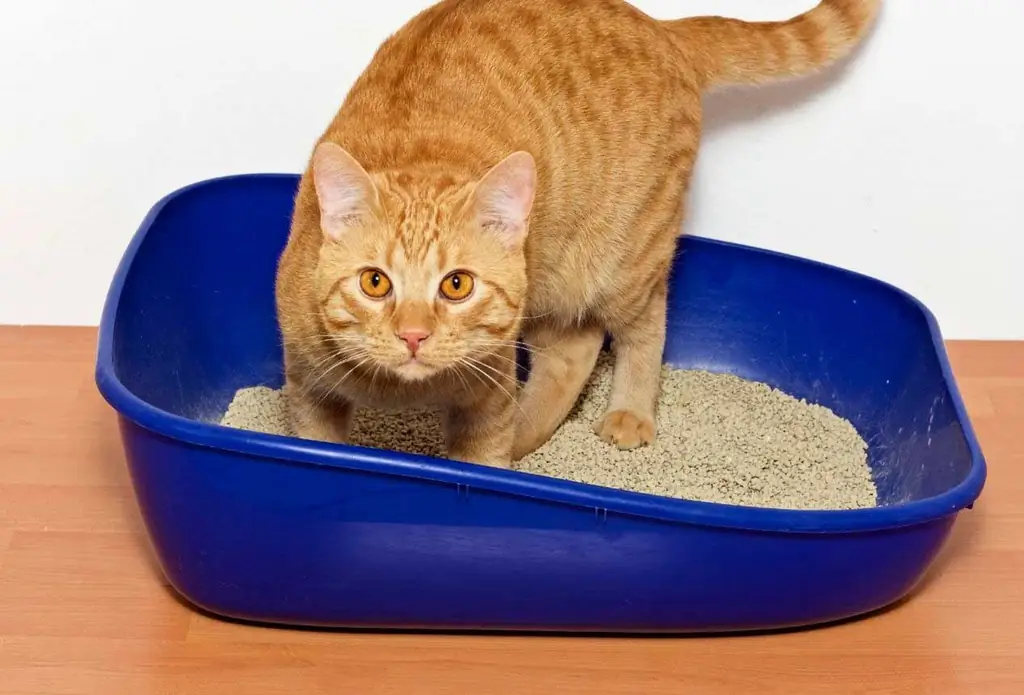
How to choose the right cat litter. What are the types of fillers, their advantages and disadvantages. Review of popular brands. Reviews
How To Make A House For A Cat And A Cat With Your Own Hands: Types Of Cat Houses (out Of The Box, Other), Drawings, Sizes, Instructions, Photos Step By Step

Requirements for the cat house. Step-by-step instructions for making a house from different materials. Where is the best place to place a house for a cat
